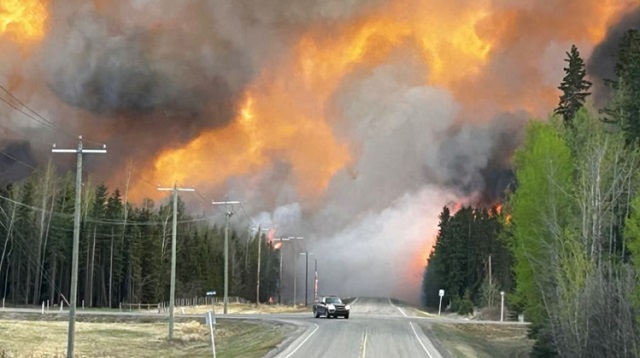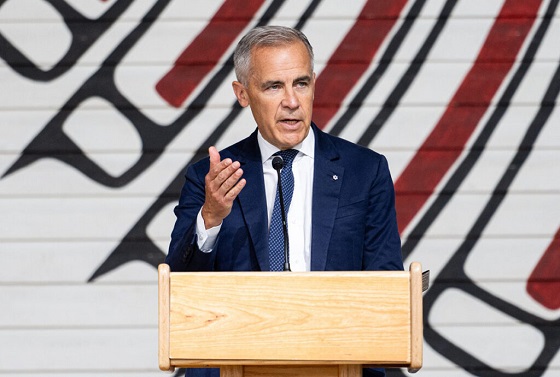Alberta
Thank the beetle and deadwood ‘fuel’ that should have been cleared

By Josh Andrus
Originally posted in the Western Standard
Parks Canada officials admit they failed to conduct controlled burns of dead pine trees, which now pose a significant fire risk.
While Ottawa fixates on climate change rhetoric, their neglect of forest fire prevention has left Alberta’s landscapes vulnerable to devastation.
Last week, a shining beacon of the beauty of our province was partially destroyed as a wildfire burned through the picturesque town of Jasper. Our thoughts and prayers go out to the victims.
Thankfully there has been no reported loss of life. But many people’s livelihoods have been wiped out. The question is how did this happen, and what could have been done to prevent it?
Smokey Bear’s famous saying was: “Only you can prevent forest fires.” And, in this case, proactive measures certainly could have made a difference.
Unfortunately, the entire federal government seems to have forgotten Smokey’s key point. Fire prevention on national park land is federal jurisdiction.
In 2022, Environment Minister Steven Guilbeault was informed that Parks Canada managers had not taken adequate precautions to protect the Town of Jasper from wildfires, according to documents obtained by Blacklock’s Reporter. At that time, Parks Canada officials admitted they had failed to conduct controlled burns of dead pine trees, which posed a significant fire risk.
“A mountain pine beetle infestation has brought significant changes to forests in Alberta, including Jasper National Park, with consequences for wildfire risk,” Guilbeault was informed.
Almost half of Jasper’s Whitebark Pine forest, 44%, was infected by beetles. However, few steps were taken to reduce the risk to the Town of Jasper with controlled burns of the surrounding forest, records show.
“Fire has not yet been applied for Whitebark Pine restoration,” stated a 2022 implementation report. “Mechanical thinning has been completed in 1.6 hectares, which is a small area relative to the amount of Whitebark Pine habitat.”
No reason was given for failing to take precautions. Since the fire, Guilbeault has made no public mention of the management reports.
Even though federal officials, including his department, knew the raging pine beetle was a serious hazard, Guilbeault blamed climate change: “As we are seeing in Canada and all around the world, we are seeing more and more aggressive forest fires,” he said on a media call on Monday.
Landon Shepherd, Incident Commander for Parks Canada, also attributed the intensity of the blazes to climate change: “This isn’t meant to be a discussion about climate change, but anyone who’s involved in fire management can tell you that things have become more difficult, especially in the last five years, to manage impacts.”
The 2022 warnings were not the first time concerns about a lack of fire prevention in national parks have been raised.
In 2018, CBC reported concerns from experts. Emile Begin and Ken Hodges, foresters for 40 years who had been studying Jasper National Park, found multiple issues with the forest that make it susceptible to a fire.
“You have fire suppression that has occurred for many years — therefore, you get a lot of dead fuel that would have been consumed by a natural process,” Hodges said. “The mountain pine beetle adds even more fuel to the situation.”
“You’ve got a major catastrophe on your hands if you get a match thrown into that.”
When pressed about the concerns, Alan Fehr, a superintendent for Jasper National Park, said: “We’re quite comfortable with where we are with our own emergency planning and evacuation planning.”
Hodges disagreed: “The potential that’s out there is actually scary. Hopefully, we’re wrong.”
Despite the repeated warnings of potential devastation due to forest management practices, Ottawa continues to point to climate change as the cause of the fires.
The Alberta government has been preparing, and increased its firefighting budget by more than 50% to $155.4 million this year. Alberta’s firefighting budget is now the highest it has ever been (despite misinformation about cuts.)
However, without proper fire prevention on national park land, blazes can become out of control quickly — as the warnings indicated.
Smokey Bear would be horrified. Clearly, Ottawa needs to spend less time interfering in provincial jurisdiction and more time focusing on things that actually are federal jurisdiction, like fire prevention in national parks.
Their inability to see the forest through the trees and take legitimate action to protect our national parks from the fury of an out-of-control wildfire demonstrates a degree of ineptitude that is, quite frankly, shocking.
Ottawa needs to stay in its lane and focus on its own jurisdiction, and they need to stop blaming climate change for their own ineptitude.
Alberta
Mark Carney Has Failed to Make Use of the Powerful Tools at His Disposal to Get Oil Pipelines Built

From Energy Now
By Jim Warren
It can be refreshing when politicians clearly and unequivocally state their positions on important public issues. That’s what former BC premier, John Horgan, did during the 2017 BC provincial election campaign.
Horgan forthrightly announced he would use “every tool in the tool box” to stop the Trans Mountain pipeline expansion (TMX). For the next three years, Horgan stayed true to his word. Enthusiasm for the fight waned somewhat in July of 2020 when the Supreme Court foreclosed on any further delays over things like a lack of consultations with First Nations.
Of course, how one feels about frank and honest statements by politicians can depend on who is losing out. It can be less refreshing when every tool available is being employed in service of a measure you oppose. But, you at least have a better idea about what you are up against when your opponent clearly spells out where he stands.
The tool box has not been used much in support of pipelines
At this point in Mark Carney’s first year as prime minister it’s become rather obvious, he rarely employs any of the tools at his disposal in support of new oil pipelines. One might reasonably conclude that the opposite is the case—the vast powers of the Prime Minister’s Office (PMO) and the Government of Canada have been employed in opposition to any new oil pipelines to any Canadian coast.
The Liberal government has tried and failed to sell supporters of the oil industry on the idea that Bill-C5, The Building Canada Act, has paved the way for a new pipeline to Canadian tidewater. The prime minister knows Bill C-5 won’t do that.
Ninety some CEOs from Canada’s oil and pipeline sector have informed the PM that Bill C-5 by itself will do nothing to get a pipeline to any coast. They have sent letters saying this to Carney on three separate occasions since he became prime minister. One point repeatedly stressed by the CEOs as well as the Government of Alberta is that it is not possible to build a pipeline from Alberta to the West coast without the repeal of, or significant amendments to, the West Coast Tanker Ban, Bill C-48, and the Impact Assessment Act, formerly Bill C-69 (aka the No More Pipelines Bill).
Carney’s failure to address those concerns defies logic and common sense. The approval and completion of an oil pipeline from Alberta to Prince Rupert under Bill C-5, is in direct conflict with the tanker ban and would face virtually the same insurmountable barriers the Impact Assessment Act presented for previously cancelled pipeline projects. It is not logically possible for all three things to be true at the same time (i.e. Bills C-48 and C-69 remain in place and a pipeline to Prince Rupert is completed)
What possible harm could arise if the prime minister simply stated something to the effect that the boundaries of the region where oil tankers are banned under C-48 will be adjusted to accommodate pipeline projects approved under Bill C-5? You wouldn’t think saying so would remove any hide from Carney’s butt and would provide greater assurance to prospective pipeline proponents.
Wrong.
Carney will not say anything of the sort. That’s because he is more concerned about staying on the good side of the environmental activists who are among his most fervent supporters. The environmental groups leading the crusade against climate change, climate alarmed members of Carney’s caucus, and cabinet would just as soon see the tanker ban remain in place. They want Bill C-48 to serve as a trip wire to thwart projects like a revived Northern Gateway project. They would similarly balk at any tinkering with the Impact Assessment Act which might facilitate the approval and completion of such a pipeline.
Follow the money
Just follow the money. Here’s one of the many pieces of evidence we might consider. Mark Carney has been shoring up his support among anti-oil environmentalists with government cash. Among the un-budgeted expenditures announced by the government in early 2025 was the $206 million to be spent over the next five years under the auspices of the Climate Action Awareness Fund (CAAF). The funds will be used to combat the declining urgency among Canadians for combating climate change. The initial tranche of $14.4 million issued so far this year will be available to help young Canadians address climate change. It appears the principal delivery agents for CAAF funded projects will be environmental organizations, including those groups who were active in the infamous anti-Alberta oil campaigns.
In other words anti-oil environmental groups stand to be among the beneficiaries of $41.2 million per year in government largesse. This level of support is far more generous than the roughly $16.5 million, per year, Alberta’s Allan Commission reported Justin Trudeau’s government had been lavishing on anti-oil environmental groups.
No doubt the Liberals will claim the millions in CAAF funding is a wise investment as opposed to what it really is—an expensive perk for the government’s green supporters. It makes sense to expect the efforts of some of the groups being funded will be devoted to handcuffing the oil industry.
The tool box is actually wide open. It’s just not being used in support of increasing Canadian oil production, exports and revenues.
The tool box is far from empty
The bully pulpit available to the prime minister’s office (PMO) may indeed be far less influential than the one available to a US president. Nevertheless, a clear and unequivocal statement by the nation’s prime minister in support of building a new pipeline to the coast, under reasonable approval requirements, would go a long way toward encouraging potential proponents and reducing public angst and anger in the oil producing provinces.
Canada’s prime ministers have near Trumpian powers at their disposal should they choose to use them. The Justin Trudeau Liberals used the heavy hand of the Emergencies Act to stifle horn honking in Ottawa. Sure, the courts said using the Act in that instance was an overreach on the part of the government, but nobody in government was penalized for imposing it.
If the Emergencies Act isn’t enough to bulldoze a pipeline through to the coast the government can dust off the “peace, order and good government,” powers assigned to Ottawa under Section 91 of the Constitution. And let’s not forget the notwithstanding clause—available to stifle spurious lawsuits claiming that a pipeline is offending someone’s rights.
Admittedly, making use of those two options sounds pretty silly. However, it was Carney himself who suggested he was prepared to do something along these lines on one of the two or three occasions when he slipped up and gave people the impression he would back a pipeline. When campaigning in Kelowna last winter the prime minister said he would use all the powers available to the federal government to get one built. Since then he has backtracked, given Quebec a veto over pipelines to the East coast, and indicated any effort to get a new pipeline approved would require a national consensus and be subject to legislation and regulatory checks that would be extremely difficult if not impossible to meet.
Mark Carney is no John Horgan
Clearly, Mark Carney is no John Horgan. Our prime minister continues to dissemble, obfuscate and change the subject when it comes to getting behind a pipeline that would represent the most economically significant, nation building project capable of producing huge revenues within a relatively short period of time.
The recent federal budget did little to increase the possibility of getting a new export pipeline anytime soon. The conventional energy sector has been facing government barriers to growth in investments, production and exports for over a decade now. It is true the budget announced the elimination of one of those growth killing measures, the emissions cap. And the Liberals deigned to return free speech to those who support oil and gas. Saying something positive about conventional energy firms’ efforts on behalf of environmental sustainability will cease to be deemed illegal greenwashing. However, those positive changes still leave several other equally harmful policies in place.
The budget anticipates a huge increase in private sector investment in response to a package of uninspiring policy tweaks and sugar-coated forecasts. There is little, if anything, in the budget to justify its excessively optimistic predictions. On the other hand, the budget announced that carbon capture projects will not count toward emissions reduction credits if the CO2 will be used for enhanced oil recovery. This will be a bane to CO2 capture efforts in the oil sands and potentially gives the federal government another reason to stifle growth in production and exports.
The flight of investment during the Liberal years owes much to the lack of confidence generated by policies like Bills C-48 and C-69. Doing something to limit the investment killing effects of those two pieces of legislation would cost relatively little, generate billions in oil export revenue, and help restore investor confidence.
If Carney has actually decided there will be no new oil pipeline to the West coast, at some point in the near future that reality will catch up with him. Remaining elusive about pipelines today may help the Liberals should there be a snap election. But, it will do little to advance national unity and is likely to boost the independence vote in Alberta’s referendum.
Here we go again. On Friday November 7 the prime minister told attendees at Canadian Club event in Toronto not to worry the long sought pipeline “was going to happen.”
Pardon me if I’m not convinced. Over the previous three months the liberals clearly acted as though becoming an energy super power could happen without increasing oil production and exports.
Alberta
School defunding petition in Alberta is a warning to parents

This article supplied by Troy Media.
A union-backed petition to defund independent schools in Alberta could trigger a wave of education rollbacks across Canada
A push to defund independent schools in Alberta is a warning to every Canadian parent who values educational options.
A petition backed by the Alberta teachers’ union may be the first step toward reduced learning choices across Canada. Independent schools, most of them non-elite and often focused on a specific pedagogical approach, receive partial public funding in Alberta and serve diverse student populations.
The petition, launched under Alberta’s citizen initiative law, could trigger a provincewide referendum if it meets the required threshold set by provincial election law.
If your child isn’t in a standard public classroom, whether they’re home-schooled, in a charter, Francophone, Catholic, or
specialized public program, this petition puts your educational decisions at risk.
Opponents of choices in education have been forthright in their attempts to erode the large and successful range of learning options that most Canadians enjoy. Instead, they seem to be aiming for a single, uniform, one-size-fits-all system with no variation for children’s many learning styles and needs, nor for new teaching innovations.
During last year’s NDP leadership campaign in Alberta, candidate (and current MLA) Sarah Hoffman proposed effectively eliminating charter schools and forcing them to join public school boards.
The current recall effort targeting Alberta Education Minister Demetrios Nicolaides lists “charter-private school” funding as a rationale. There is no such thing as a charter-private school, since charter schools are public and 100 per cent provincially funded.
It’s clear the petition is aimed at restricting or defunding charter schools despite their popularity. More than 15,000 students are enrolled and over 20,000 more are on wait-lists in Alberta.
Alberta isn’t the only place where schooling options are coming under pressure. Yukon’s NDP leader has called for defunding and eliminating the territory’s entire Catholic separate system. Similar arguments exist in Ontario. British Columbia doesn’t have a Catholic school system. Newfoundland had one, but in 1998 merged the Catholic board into the public one.
Going as far back as 2010, provinces including Newfoundland, British Columbia, P.E.I. and Nova Scotia have sought to justify limiting the Francophone schooling options they offer due to high costs and budget limitations.
These provincial actions raise a larger question. Efforts to defund Catholic and Francophone schooling are striking, given that both are constitutionally protected. If, as teachers’ unions argue, even constitutionally protected choices can be defunded, restricted or eliminated, how safe are all the other options, like independent, charter, or microschools that aren’t written into the constitution but excel at producing well-formed, knowledgeable graduates ready for adulthood?
Even specialized programs offered within the public system aren’t safe. Last year, the Calgary Board of Education shut down its all-boys program, saying the space was needed to accommodate general enrolment growth. However, the building was then leased out to a post-secondary institution. In Vancouver, the public board stopped new enrolment in its gifted student program, ending “the only publicly funded option for kids who need an accelerated learning environment.”
If these formal attacks on educational diversity can happen in Alberta, which has long been Canada’s leader in making a wide variety of learning options available, affordable and accessible to families, then it certainly can happen in other provinces as well.
The Saskatchewan Teachers’ Federation has already asked the government to end funding for independent schools. A similar push has surfaced in British Columbia. The claim that independent schools drain resources from the public system is incorrect. Every student who enrolls in an independent school costs the provincial budget less and frees up space, teaching time, and other public school resources for everyone else.
These efforts reflect a zero-sum view of education and a false view that only some schools serve the common good.
A better approach is to expand what’s available. Provinces can support more learning options for families, which means more resources and better results for students, no matter how or where they learn.
We need to pay attention to what’s happening in Alberta and elsewhere. Parents don’t want fewer options to help their children enjoy school and flourish academically or personally. If educational diversity can be rolled back in Alberta, it can be rolled back anywhere.
Canadians who value educational alternatives need to pay attention now—before the decisions are made for them.
Catharine Kavanagh is western stakeholder director at Cardus, a non-partisan thinktank that researches education, work and public life.
Troy Media empowers Canadian community news outlets by providing independent, insightful analysis and commentary. Our mission is to support local media in helping Canadians stay informed and engaged by delivering reliable content that strengthens community connections and deepens understanding across the country
-

 armed forces2 days ago
armed forces2 days agoIt’s time for Canada to remember, the heroes of Kapyong
-

 Business2 days ago
Business2 days agoCarney’s Floor-Crossing Campaign. A Media-Staged Bid for Majority Rule That Erodes Democracy While Beijing Hovers
-

 Business1 day ago
Business1 day agoLiberals refuse to disclose the amount of taxpayer dollars headed to LGBT projects in foreign countries
-

 Daily Caller22 hours ago
Daily Caller22 hours agoUS Nuclear Bomber Fleet Shares Fence With Trailer Park Linked To Chinese Intel-Tied Fraudster
-

 Agriculture2 days ago
Agriculture2 days agoBovaer Backlash Update: Danish Farmers Get Green Light to Opt Out as UK Arla Trial Abruptly Ends!
-

 Digital ID1 day ago
Digital ID1 day agoCanada moves forward with digital identification for federal benefits seekers
-

 Alberta1 day ago
Alberta1 day agoSchool defunding petition in Alberta is a warning to parents
-

 COVID-1921 hours ago
COVID-1921 hours agoSpy Agencies Cozied Up To Wuhan Virologist Before Lying About Pandemic









